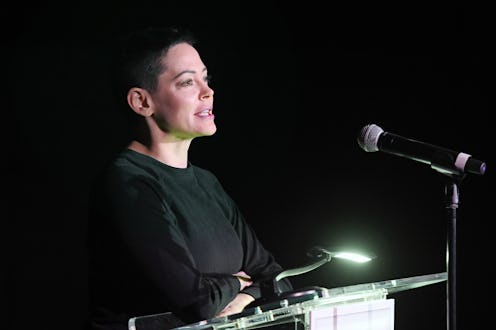News
This Is The Absolute Wrong Response To 'TIME's "Silence Breakers"

TIME magazine chose "The Silence Breakers" as its 2017 Person of the Year, a decision lauded by many people as an important recognition of the #MeToo movement and how rapidly the culture is changing. But amid the praise for those who have gone public about their sexual assault or harassment, many people are responding to TIME's Person of the Year by castigating the women and men for taking so long to come forward.
Things have changed since The New York Times and The New Yorker first exposed Harvey Weinstein's decades-long history of being accused of sexual assault and harassment (accusations he has denied). A long list of powerful men have been outed as sexual predators to serious consequences. After decades — nay, centuries — of being belittled, dismissed, and discredited for going public about being sexually abused, assaulted, or harassed, society is finally starting to believe women.
"Why did the silence breakers take so long to break their silence?" This is the kind of comment that has persisted not just since TIME published its Person of the Year on Wednesday morning. We heard it when Weinstein's accusers went public. We heard it repeatedly from Republican Senate candidate Roy Moore, who has vehemently denied accusations of molesting underaged girls in the 1980s by questioning why his accusers are only coming forward now, decades later. We heard it from President Trump, who has repeatedly denied allegations of sexual assault and predatory behavior and questioned why they were only surfacing decades after they allegedly happened. We heard it in statements from men responding to accusations of sexual misconduct, and we are almost guaranteed to hear it again when longtime allegations against another man goes public.
Yet this very question is why it takes so long for survivors to break their silence. From the moment abuse or harassment happens, the odds are fiercely stacked against victims, who often enter a state of shock directly after. Just consider how many women who broke their silence have detailed how they felt "frozen" and unable to respond, and after escaping their abuser, broke down sobbing.
The backlash to women going public about their sexual assault and harassment is something we've seen play out over and over again. Men like Moore and Trump who are accused of misconduct have attempted to smear their accusers' credibility, and the women's personal histories — if anything less than pristine — have been held up as "evidence" that they are liars.
What's more, survivors of sexual assault and harassment aren't just fighting to hold their accuser accountable; they are pushing back against an entire system that has repeatedly demonstrated how ill-equipped it is to help survivors.
Take the horrific experience Megan Rondini was put through after she went to the Tuscaloosa, Alabama, police to report that she was raped. Then a University of Alabama student, BuzzFeed News reported that Rondini alleged that a prominent Tuscaloosa businessman raped her one night in his home, and she went to the police immediately after to file a report. The businessman's lawyer denied the allegation and insisted their encounter was consensual.
Law enforcement ultimately built a case against Rondini instead — she had taken her alleged attacker's gun while looking for her keys as she tried to escape — and concluded that no rape took place. She tried to seek counseling from a school therapist, but the therapist ended up recusing herself from Rondini's case because she knew the businessman's family.
Rondini left the school and was diagnosed with post-traumatic stress disorder. Months later, she committed suicide.
Rondini's horrific experience would dissuade any survivor of sexual violence from coming forward. But it also illustrates how broken the system is — even when someone comes forward immediately after their alleged assault, it fails them.
No wonder, then, that survivors stay silent for decades. No wonder they feel reluctant to come forward about their abuse, if they know with near certainty that their character and past will be dragged into the public eye. No wonder why so many of the "silence breakers" in TIME's feature took so long to speak out. (And even then, not everyone included in its Person of the Year was willing to take the risk. The magazine's cover highlighted a woman's arm, a hospital worker who TIME explained "doesn’t feel that she can come forward without threatening her livelihood.")
As #MeToo continues take down abusers and predators, TIME's "Silence Breakers" feature is not only a nod to its impact, it's also fuel to drive the movement even further. Don't ask why it took so long for accusers to break their silence; ask instead how long it will take for you to finally believe them.
Editor's Note: This op-ed does not reflect the views of BDG Media and is part of a larger, feminist discourse on today's political climate.